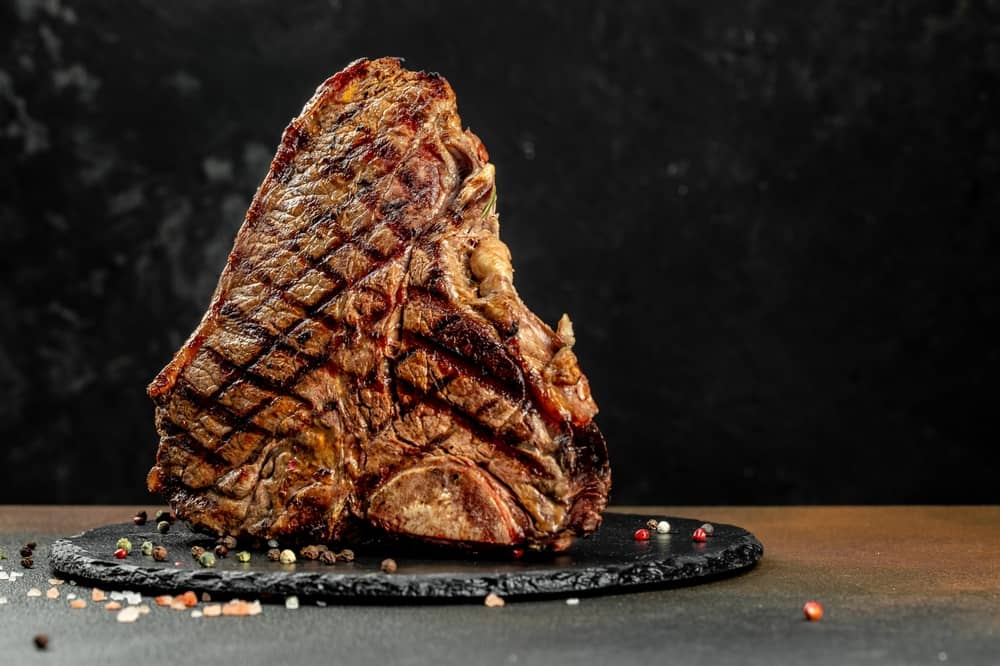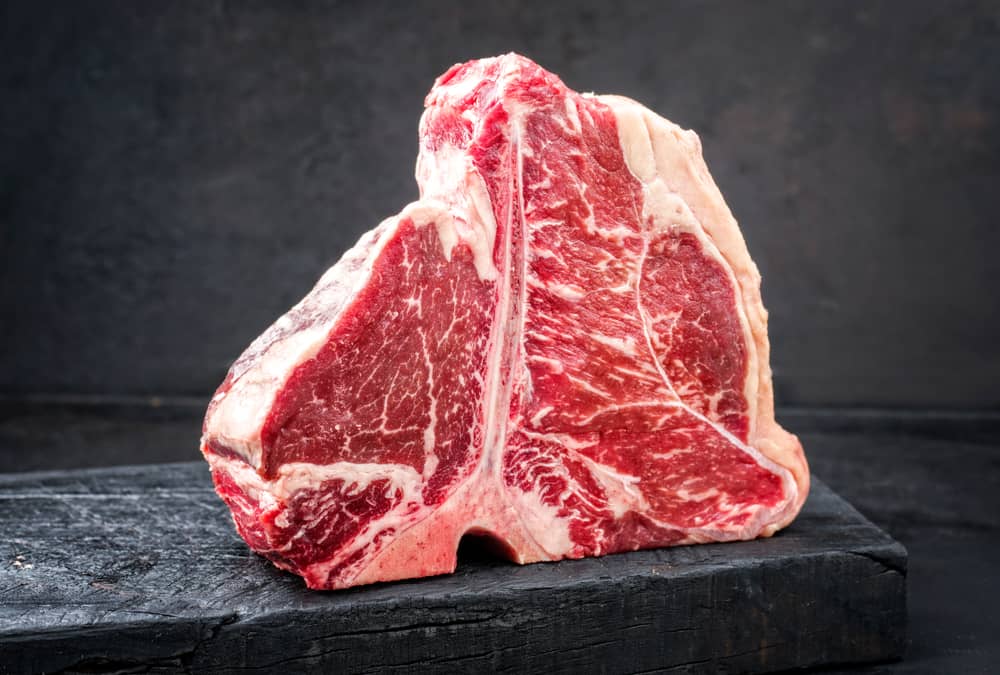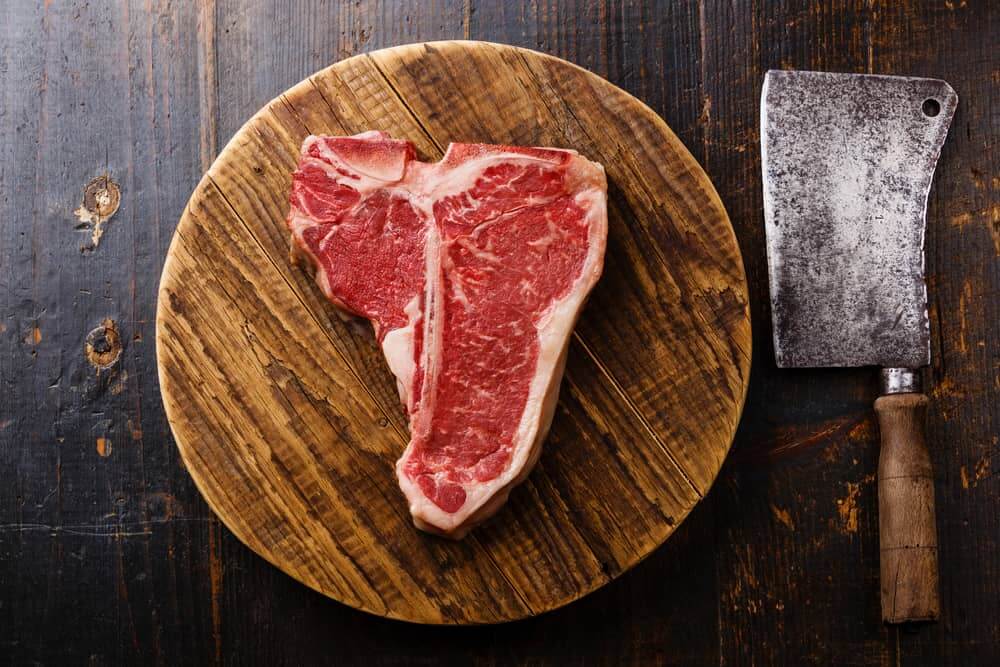
A lot of people will try to tell you there isn’t a difference between a porterhouse steak and a T-bone steak. All it takes, they say, is one look at the same T-shaped bone – meat on one side, more meat on the other – to know they’re the same cut of meat.
Well, a lot of people couldn’t be more wrong.
It’s true that T-bones and porterhouses are cut from the same section of the cattle (the short loin), and both hold the same kinds of meat (the NY strip and the tenderloin filet). But the United States Department of Agriculture, or USDA, has strict rules about how much beef belongs on a porterhouse or T-bone.
Learn the difference for yourself and bone up on why porterhouses, in particular, are such prized cuts of steak below.
What Goes into a Porterhouse or T-Bone
Porterhouse and T-bone steaks are types of meat that are both cut from the short loin area of cattle. The T-shaped bone that the T-bone steak is named after runs through two different kinds of steak in this part of the cow. Steak lovers highly prize both of these cuts. One side of the bone is a NY strip, second only, perhaps, to the rib-eye in terms of beef quality. On the other side is a tenderloin filet: extra-lean, and super tender.
Each of these cuts is often removed from the bone and served on their own. It’s only when both filet and strip are left on the bone that you get a porterhouse or T-bone.
Nutritional Value of Porterhouse Steak
One pound of porterhouse can easily top 1,000 calories, which is why it’s important to be mindful of how much you eat. A serving size of steak is considered 3 ounces. For a porterhouse, this equals somewhere between 200 and 250 calories. Add a baked potato and some leafy vegetables as a side to create a filling meal that falls in a good calorie range.
As for nutritional value, the porterhouse is low in carbs and has about 20 to 25 grams of protein per serving. Like other steaks, it’s also an excellent source of iron, phosphorus, riboflavin, zinc, Vitamin B6, and other vitamins and minerals that your body needs every day.
Just be careful to avoid too much fat. Porterhouse is high in good-for-you polyunsaturated and monounsaturated fats, but it’s also high in bad saturated fat. You can trim your beef prior to grilling or cooking in an iron skillet to remove steak fat.
Size Matters
So what actually sets a porterhouse apart from a T-bone? The primary difference between porterhouse vs T bone comes down to the size of the filet.
Porterhouse steaks have more filet to them than T-bones. The USDA – generally considered the arbiter of all things beef-related – has strict guidelines for the size of the filet cut that has to be present for a steak to qualify as a porterhouse. To put it another way…
Porterhouses Are T-Bones…
For a T-bone steak to qualify as a porterhouse, the United States Department of Agriculture says that the filet is required to be at least 1.25 inches thick. Thickness is measured from the bone to the widest point on the filet. Porterhouses come from the rear of the short loin, where the tenderloin is thickest. The result is an incredibly hefty cut of steak. Many porterhouses weigh in the range of 24 ounces and are served at steakhouses as meals for two. These are the steaks you often see in photos for steakhouse marketing, Instagram feeds, and other photos where having a huge, eye-catching steak is a must. It’s probably also what you picture when you think of a steak that’s ready to fill your plate.

…But a T-Bone Isn’t a Porterhouse
If a T-bone’s filet falls short of the 1.25 inches mark, it can only be labeled as a T-bone steak. It is important to note that a T-bone’s filet must be at least 0.25 inches thick to be sold as a T-bone. Otherwise, it might just be sold as a bone-in NY Strip or a Club steak.

Porterhouse vs T Bone: Price Difference
For either cut, those marked with USDA Prime will have the highest cost, but this goes for just about any steak cut, like a rib eye or boneless strip, because these are considered nearly perfect steak with excellent marbling. But, which choice of beef is usually the more expensive one?
Because of their ample filets, porterhouse steaks are priced far higher than T-bone steaks, in general. However, some steaks that qualify as porterhouses might have filets that are thick in one section and thin in the rest, so pay close attention to the filet’s overall size when you pick one out.
Ultimately, the cost difference between the two will come down to a variety of factors, like quality, how many pounds they are, how long they were aged, and even where you buy them from. A portion of porterhouse or T-bone from a butcher is probably going to be more expensive than a portion from a supermarket, simply because of the quality you’re getting.
Cooking Porterhouse vs T Bone
Your piece of porterhouse or T-bone will cook similarly, being that they come from the same part of the cow and have the same texture. The key difference when cooking them will be your cooking time. The porterhouse generally will take a little extra time because of the size of its filet.
When it comes to the method of cooking each one, though, you can opt for the same. Cooking a steak like a porterhouse or T-bone is usually best managed with a cast-iron skillet, which gives it the ultimate sear and leaves the inside a perfect medium-rare pink. Season the steak with salt and pepper generously before cooking to help it brown with a nice crust, and you’re good to go. You can always finish the steak in the oven, tented with aluminum foil, to bring it to the proper internal temperature without overcooking its outside.
You might also use your favorite steak rub to season the steaks and then set them on your charcoal or gas grill. Sear them first on the hot side of the grill and then move them over to a low-heat side to finish off the cooking process before you serve them. Grilled porterhouse steak deepens its already delicious flavors and gives it beautiful grill marks, just like you’d expect the grill to do for any grilled steak. Top with mushrooms, onions, and peppers, or go for your favorite steak sauce for a flavor boost. Try these grilling tips to get just the right cook.
Need some recipe inspiration for your porterhouse steak? Check out these articles:
- Blue cheese crusted steaks
- Parmesan-crusted steak
- Garlic steak and herbed potatoes
- Sweet balsamic steak marinade
When Is My Porterhouse Steak Done Cooking?
As a steak lover, you probably already know the ideal internal temperature of steak to reach your desired doneness. Porterhouses are no different, so you can follow our guide to steak temperatures to get the perfect porterhouse cook.
When a meat thermometer inserted into the center of the meat reaches the temperature you need, you can take the steak out of the pan, oven, or grill, and lay it on a cutting board. Let the meat rest for five to ten minutes to let each piece reabsorb the juices. You can then top with a little butter, sea salt, and black pepper, if desired, and enjoy!
Storing Porterhouse Steak
Porterhouse steak can safely store in the refrigerator for up to two days after you buy it, unless the “Sell By” date comes before that time. Your porterhouse steak should look deep red and not have any slippery film or an unpleasant smell when you’re ready to cook it. If you think you’re not going to be able to cook porterhouse steak within that timeframe, you should place it in a freezer storage bag, removing as much air as possible before placing it in the freezer.
When you purchase these beef cuts from Chicago Steak Company, they’ll arrive in our signature box, all individually wrapped for your convenience. They come flash-frozen, so you can keep them frozen until you’re ready to use them or start thawing them immediately if you plan to use them within the next couple of days.
Tips When Choosing Between Porterhouse vs T Bone Steaks
We want you to find the best portion of T-bone or porterhouse to fit your budget, so here are a few tips to help you do that.
First, be aware that some T-bones actually contain more of a filet piece than certified porterhouses. If you can find a T-bone with consistent filet thickness, you can get something close to a porterhouse cut (without having to pay the porterhouse price). Basically, you’ll need to use your porterhouse vs T bone investigative skills to figure out how you can best maximize your budget based on how much meat you’ll get from the steaks you choose.
Second, you can tell for sure what kind of beef steaks you’re getting by paying attention to some numbers on the label. For USDA-certified meat, you can find what’s known as an Institutional Meat Purchase Specifications (IMPS) number on the label. This is a code that notes what type of meat it is under USDA standards, which may also be followed by a description of the meat, like its quality, any added ingredients, etc. For porterhouse, look for code 1173; T-bone is 1174. (Note: This also works with other steaks, like hanger steak or rib eye, so you can always have command over your red meat choices!)
Finally, because T-bones and porterhouses are made of two kinds of beef, which cook at different rates and taste best at different temperatures, try the following cooking trick. When grilling your steak, build a flame on only one side of the grill. After searing the steak, cook it by keeping the strip section over the flame, pointing the filet toward the non-flame section. This will leave the filet slightly rarer, resulting in a better-tasting steak.
Alternatives to Porterhouse Steak
Not sure if a porterhouse is right for you? We suggest trying a T-bone, which has much of the same flavor as porterhouse steak but with a bit less meat and a lower price tag. You can also opt for the filet mignon if you crave the tenderloin portion of a porterhouse steak. Or, choose the strip steak, which is also extremely tender and cooks perfectly on the grill.
Try Premium Porterhouse Today
Check out Chicago Steak Company’s premium T-bone and Porterhouse steaks to try to some of America’s juiciest and most quality beef. For more grilling tips on how to achieve the perfect porterhouse or T-bone, check out Steak U TV.
Porterhouse vs T-Bone FAQs
Porterhouse and T-bone steaks are both cut from the short loin section of cattle. The T-shaped bone, where T-Bone’s name derives, runs through two different kinds of steak. One side of the bone is a NY strip. On the other side is a tenderloin filet. These cuts are often removed from the bone and served on their own, but when both filet and strip are left on the bone you get a porterhouse or a T-bone. The difference comes down to the size of the filet. Porterhouses Are T-Bone, but a T-Bone Isn’t a Porterhouse For a T-bone steak to qualify as a porterhouse, the filet is required to be at least 1.25 inches thick from the bone to the widest point on the filet. If a T-bone’s filet falls short of the 1.25-inch mark, it can only be labelled as a T-bone steak. It is important to note that a T-bone’s filet must be at least 0.25 inches thick to be sold as a T-bone. Thanks to the larger filet, porterhouse steaks are priced far higher than T-bones. When grilling your Porterhouse or T-Bone steak, build a flame on only one side of the grill with the strip section over the flame, and the filet towards the non-flame section. This will leave the filet slightly rarer, resulting in a better tasting steak. For more grilling tips on how to achieve the perfect porterhouse or T-bone, check out Steak U TV.

